The sandy areas by the sea warm up quickly. The
flora of the dunes is not rich, but the areas of fine grass behind the
dunes develop a diverse range of interesting and colourful flowers
including the Wild Pansy. The clifftops have a heath turf of short tough
plants which includes the very rare Scottish Primrose and the very
common Sea Pink.
Inland the heavy cold peaty ground warms less quickly
and plants are slow to emerge from their winter state. But the sun
and warmer winds bring flowers to the Great Sundew as its new leaves
make ready to catch insects for its nourishment. In the less peaty
places the Common Sedge shows its black flowers and in a secret place
along the banks of the Thurso river the Holy Grass is amongst the first
of the grasses to bring out flowers.
The cultivated fields have been ploughed, harrowed
and sown. The weed seeds hurry to germinate and grown in
competition with the crop and the Wild Pansy and the Charlock are two of
the most prominent.
Charlock (Sinapis arvensis)
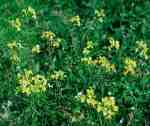 The ploughed fields spring to life, not only with
crops, but also with agricultural weeds. Some are very colourful
and a common and noticeable one is Charlock, with its yellow four-petalled
flowers. It dies back in the winter to a brown tangle of stalks
and seeds which provide wintering birds with cover and food.
The ploughed fields spring to life, not only with
crops, but also with agricultural weeds. Some are very colourful
and a common and noticeable one is Charlock, with its yellow four-petalled
flowers. It dies back in the winter to a brown tangle of stalks
and seeds which provide wintering birds with cover and food.
Great Sundew (Drosera anglica)
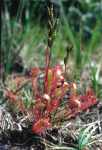 On the peatmoors and acid wetlands the summer is slow
to start since the soil is heavy and cold. Even when it has warmed the
conditions are not attractive to most plants. Some specially
adapted species prosper and one of these is the Great Sundew. It is able
to make up for the lack of nitrogen in the soil by catching and
digesting insects. Its leaves are covered in sticky hairs which catch
small insects; the hairs then exude a digestive juice which dissolves
the soft parts of the insect. The juice can then be reabsorbed
into the leaf. It is less common than the Round-leaved Sundew and
prefers a wetter part of the peat moor or the shallow margin of a loch.
On the peatmoors and acid wetlands the summer is slow
to start since the soil is heavy and cold. Even when it has warmed the
conditions are not attractive to most plants. Some specially
adapted species prosper and one of these is the Great Sundew. It is able
to make up for the lack of nitrogen in the soil by catching and
digesting insects. Its leaves are covered in sticky hairs which catch
small insects; the hairs then exude a digestive juice which dissolves
the soft parts of the insect. The juice can then be reabsorbed
into the leaf. It is less common than the Round-leaved Sundew and
prefers a wetter part of the peat moor or the shallow margin of a loch.
Common Dog-violet (Viola riviniana)
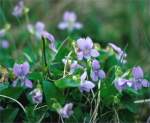 This is the most common purple violet in Caithness.
It likes drier places in grassland and shady nooks in woodland or rough.
It has heart-shaped leaves which distinguish it from the other common
purple violet, Viola palustris (which has round leaves).
This is the most common purple violet in Caithness.
It likes drier places in grassland and shady nooks in woodland or rough.
It has heart-shaped leaves which distinguish it from the other common
purple violet, Viola palustris (which has round leaves).
Common Sedge or Black Sedge (Carex nigra)
 Sedges are an important part of the grassy flora of
Caithness. Many sedges have the male and female flowers separated
into spikes, as in the common sedge of this picture. The male
flowers are at the top, with yellow stamens which carry the pollen. The
female flowers are lower and have white styles which protrude from the
“glume” - the scale which protects the flower. Later in the season
the nut will develop underneath the glume. The common sedge can be
found in the sweeter wet places in Caithness - in burns and boggy
hollows on the clay ground.
Sedges are an important part of the grassy flora of
Caithness. Many sedges have the male and female flowers separated
into spikes, as in the common sedge of this picture. The male
flowers are at the top, with yellow stamens which carry the pollen. The
female flowers are lower and have white styles which protrude from the
“glume” - the scale which protects the flower. Later in the season
the nut will develop underneath the glume. The common sedge can be
found in the sweeter wet places in Caithness - in burns and boggy
hollows on the clay ground.
Hawthorn (Crataegus monogyna)
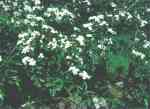 This is naturally a small tree which can be found up
to 5 metres high in Caithness. It is commonly planted as a
hedgerow and in June the flowers - most commonly white, but sometimes
pink - line our roads. I suspect that none of it is native to Caithness,
but introduced. In exposed places it becomes wind-pruned, being killed
off on the windward side and growing on the sheltered side, to be come a
very lop-sided shape.
This is naturally a small tree which can be found up
to 5 metres high in Caithness. It is commonly planted as a
hedgerow and in June the flowers - most commonly white, but sometimes
pink - line our roads. I suspect that none of it is native to Caithness,
but introduced. In exposed places it becomes wind-pruned, being killed
off on the windward side and growing on the sheltered side, to be come a
very lop-sided shape.
Holy-grass (Hierochloe odorata)
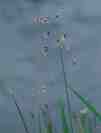 The first accepted finding of Holy-grass in Britain
was by Robert Dick of Thurso around 1854 (the bashful man had found it
twenty years earlier but not told anyone). It is now known from Orkney,
the Western Isles, south-west Scotland, Northern Ireland and a few other
scattered places, but remains a rare plant. In Caithness it occurs in
quantity on the banks of the
Thurso river,
further south than the original site reported by Dick.
The first accepted finding of Holy-grass in Britain
was by Robert Dick of Thurso around 1854 (the bashful man had found it
twenty years earlier but not told anyone). It is now known from Orkney,
the Western Isles, south-west Scotland, Northern Ireland and a few other
scattered places, but remains a rare plant. In Caithness it occurs in
quantity on the banks of the
Thurso river,
further south than the original site reported by Dick.
Wild Pansy (Viola tricolor)
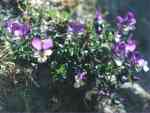 On the dunes, Sandside, Dunnet and Keiss and other
seaside sands, is Viola tricolor ssp. curtisii as shown in the
picture. It differs little from the agricultural version Viola
tricolor ssp. tricolor. Which can be seen amongst the crops in a
cultivated field. It flowers in early summer.
On the dunes, Sandside, Dunnet and Keiss and other
seaside sands, is Viola tricolor ssp. curtisii as shown in the
picture. It differs little from the agricultural version Viola
tricolor ssp. tricolor. Which can be seen amongst the crops in a
cultivated field. It flowers in early summer.
Common Bird’s-foot-trefoil (Lotus corniculatus)
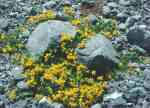 On well-drained grassy banks and bare rocky places
the bright yellow pea-flowers of the Bird’s-foot-trefoil are to be seen
in early and mid summer. The leaves are three-lobed. Later the
fruits develop, revealing how the plant gets its name, for each is long
and thin, the shape of a bird’s toe and they splay out to make the shape
of a bird’s foot. It is a leguminous plant - i.e. it has nodules on its
roots that capture nitrogen from the air and enrich the soil by making
nitrate.
On well-drained grassy banks and bare rocky places
the bright yellow pea-flowers of the Bird’s-foot-trefoil are to be seen
in early and mid summer. The leaves are three-lobed. Later the
fruits develop, revealing how the plant gets its name, for each is long
and thin, the shape of a bird’s toe and they splay out to make the shape
of a bird’s foot. It is a leguminous plant - i.e. it has nodules on its
roots that capture nitrogen from the air and enrich the soil by making
nitrate.
Scottish Primrose (Primula scotica)
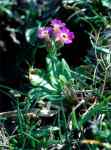 This tiny plant is a miniature beauty. It is
one to two inches high (30 to 50mm) with flowers only a quarter inch
diameter (6mm). It grows only in Scotland, indeed only in Caithness,
Orkney and North Sutherland. First found on Holborn Head in 1725, there
are still some present there. Indeed there are colonies scattered
around the Caithness coast growing in short grass on clifftops and in
the machair-like fine grassland at the back of the dunes at
Dunnet
and Keiss. It can be
seen at Sandside Head, Dunnet (ask
the Wildlife Ranger ), Keiss Links, Noss Head and many other places.
This tiny plant is a miniature beauty. It is
one to two inches high (30 to 50mm) with flowers only a quarter inch
diameter (6mm). It grows only in Scotland, indeed only in Caithness,
Orkney and North Sutherland. First found on Holborn Head in 1725, there
are still some present there. Indeed there are colonies scattered
around the Caithness coast growing in short grass on clifftops and in
the machair-like fine grassland at the back of the dunes at
Dunnet
and Keiss. It can be
seen at Sandside Head, Dunnet (ask
the Wildlife Ranger ), Keiss Links, Noss Head and many other places.
Red Campion (Silene dioica)
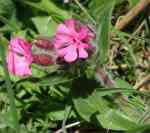 The rough grassy areas and grassy cliffs become alive
with the bright colour of Red Campion in the middle of May and the
flowering continues well into the summer. While most plants are
red flowered, white ones occur - there is a good colony near the
mausoleum on the Isle of
Stroma - and with the white comes some pink individuals.
The rough grassy areas and grassy cliffs become alive
with the bright colour of Red Campion in the middle of May and the
flowering continues well into the summer. While most plants are
red flowered, white ones occur - there is a good colony near the
mausoleum on the Isle of
Stroma - and with the white comes some pink individuals.
Thrift or Seapink (Armeria maritima)
 Thrift is very common around our coast. It grows on
grassy cliffs, in crevices in rocks in the cliff face and rocky shore,
on harbour walls, and in muddy shores. It even grows on roadsides
where the winter salt makes the soil suitable and on the rocky parts of
mountains. A most successful plant! Flower colour varies from pale
pink to deep purple and the form of the plant varies from a straggling
tangle to a tightly compacted mound, depending on exposure, light and
the nature of the substrate.
Thrift is very common around our coast. It grows on
grassy cliffs, in crevices in rocks in the cliff face and rocky shore,
on harbour walls, and in muddy shores. It even grows on roadsides
where the winter salt makes the soil suitable and on the rocky parts of
mountains. A most successful plant! Flower colour varies from pale
pink to deep purple and the form of the plant varies from a straggling
tangle to a tightly compacted mound, depending on exposure, light and
the nature of the substrate.





















